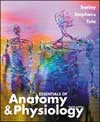 |  Essentials of Anatomy & Physiology, 4/e Rod R. Seeley,
Idaho State University
Philip Tate,
Phoenix College
Trent D. Stephens,
Idaho State University
Blood
Study OutlineFunctions of Blood
Transport of gases, nutrients, and waste products
Transport of processed molecules
Transport of regulatory molecules
Regulation of pH and osmosis
Maintenance of body temperature
Protection against foreign substances
Clot formation
Composition of Blood(Fig. 11.1, p. 293)Plasma
Characteristics
Composition(Table 11.1, p. 293) Formed Elements(Table 11.2, p. 294)Production (hematopoiesis)(Fig. 11.2, p. 295)Erythrocytes(Fig. 11.3, p. 296)Function
O2 transport
Carbonic anhydrase and pH balance
Life history
Production(Fig. 11.4, p. 297)Breakdown(Fig. 11.5, p. 298) White blood cells (leukocytes)(Fig. 11.6, p. 298)Granulocytes
Neutrophils
Basophils
Eosinophils
Agranulocytes
Lymphocytes
Monocytes and macrophages
Platelets from megakaryocytes
Preventing Blood Loss
Blood vessel contraction
Platelet plugs(Fig. 11.7, p. 299)Blood clotting(Fig. 11.8, p. 300)Stage 1 - Prothrombinase
Stage 2 - Prothrombin-thrombin
Stage 3 - Fibrinogen-fibrin
Control of clot formation-anticoagulation
Clot retraction and fibrinolysis(Fig. 11.9, p. 301) Blood Grouping
General principles
Transfusion reactions
Antigens and antibodies
Agglutination and hemolysis(Fig. 11.11, p. 303) ABO blood group(Fig. 11.10, p. 303)Rh blood group
Incompatibility
HDN (erythroblastosis fetalis)(Fig. 11.12, p. 304) Diagnostic Blood TestsClinical Focus: Some Disorders of the Bloodp.
307-308
Type and cross match
Complete blood count
RBC count
Hemoglobin measurement
Hematocrit measurement(Fig. 11.13, p. 306)WBC count (total)WBC differential count
Clotting
Platelet count
Prothrombin time measurement
Blood chemistry
|
|



 2002 McGraw-Hill Higher Education
2002 McGraw-Hill Higher Education

 2002 McGraw-Hill Higher Education
2002 McGraw-Hill Higher Education